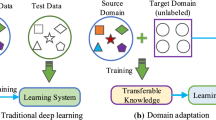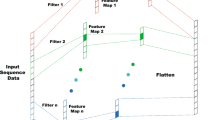Abstract
Recently, the development of intelligent data-driven machinery fault diagnosis methods have received significant attention. In most studies, the training and testing data are assumed to be collected from the same sensor. However, in real practice, due to the mounting limitation and sensor malfunctioning, it cannot be generally guaranteed to obtain the data from the same sensor location at all times. The testing and training data can be possibly from different sensor locations. Consequently, different data distributions exist, which remarkably deteriorates the data-driven model performance in different scenarios. In order to address this issue, this paper proposes a deep learning-based cross-sensor domain adaptation approach for machinery fault diagnosis. The maximum mean discrepancy is deployed as a distance metric to realize marginal domain fusion. The unlabeled parallel data is further exploited to achieve conditional domain alignment with respect to different machine health conditions. An electro-mechanical actuator dataset is used as a case study for the validation of the proposed method. Different tasks are designed to simulate different cross-sensor domain adaptation problems in fault diagnosis. The experimental results suggest the proposed method achieves higher than \(95\%\) testing accuracies in most tasks, and it offers a promising approach for cross-sensor fault diagnosis problems.







Similar content being viewed by others
References
Balaban E, Saxena A, Narasimhan S, Roychoudhury I, Koopmans M, Ott C, Goebel K (2015) Prognostic health-management system development for electromechanical actuators. J Aerosp Inf Syst 12(3):329–344
Balaban E, Bansal P, Stoelting P, Saxena A, Goebel KF, Curran S (2009) A diagnostic approach for electro-mechanical actuators in aerospace systems. In: 2009 IEEE aerospace conference, IEEE, pp 1–13
Siahpour S, Zand MM, Mousavi M (2018) Dynamics and vibrations of particle-sensing mems considering thermal and electrostatic actuation. Microsyst Technol 24(3):1545–1552
Zhang Y, Liu L, Peng Y, Liu D (2018) An electro-mechanical actuator motor voltage estimation method with a feature-aided kalman filter. Sensors 18(12):4190
Zhang Y, Liu L, Peng Y, Liu D (2020) Health indicator extraction with phase current for power electronics of electro-mechanical actuator. Measurement 159:107787
Dalla Vedova MD, Germanà A, Berri PC, Maggiore P (2019) Model-based fault detection and identification for prognostics of electromechanical actuators using genetic algorithms. Aerospace 6(9):94
Di Rito G, Schettini F (2018) Health monitoring of electromechanical flight actuators via position-tracking predictive models. Adv Mech Eng 10(4):1687814018768146
Liu H, Jing J, Ma J (2018) Fault diagnosis of electromechanical actuator based on VMD multifractal detrended fluctuation analysis and PNN. Complexity 2018:1–11
Cao Y, Wang J, Yu Y, Xie R, Wang X (2016) Failure prognosis for electro-mechanical actuators based on improved SMO-SVR method. In: 2016 IEEE Chinese guidance, navigation and control conference (CGNCC), IEEE, pp 1180–1185
Jing J, Liu H, Lu C (2017) Fault diagnosis of electro-mechanical actuator based on WPD-STFT time-frequency entropy and PNN. Vibroeng PROCEDIA 14:130–135
Narasimhan S, Roychoudhury I, Balaban E, Saxena A (2010) Combining model-based and feature-driven diagnosis approaches-a case study on electromechanical actuators
Le HX, Van Nguyen T, Le AV, Phan TA, Nguyen NH, Phan MX (2019) Adaptive hierarchical sliding mode control using neural network for uncertain 2d overhead crane. Int J Dyn Control 7(3):996–1004
Njitacke Z, Kengne J, Fozin TF, Leutcha B, Fotsin H (2019) Dynamical analysis of a novel 4-neurons based hopfield neural network: emergences of antimonotonicity and coexistence of multiple stable states. Int J Dyn Control 7(3):823–841
Pham DT, Van Nguyen T, Le HX, Nguyen L, Thai NH, Phan TA, Pham HT, Duong AH, Bui LT (2019) Adaptive neural network based dynamic surface control for uncertain dual ARM robots. Int J Dyn Control 8:1–11
Laredo D, Chen Z, Schütze O, Sun JQ (2019) A neural network-evolutionary computational framework for remaining useful life estimation of mechanical systems. Neural Netw 116:178–187
Li X, Jia X, Wang YL, Yang SJ, Zhao HD, Lee J (2020) Industrial remaining useful life prediction by partial observation using deep learning with supervised attention. IEEE/ASME Trans Mechatron PP:1–1
Li X, Li X, Ma H (2020) Deep representation clustering-based fault diagnosis method with unsupervised data applied to rotating machinery. Mech Syst Signal Process 143:106825
Li X, Siahpour S, Lee J, Wang Y, Shi J (2020) Deep learning-based intelligent process monitoring of directed energy deposition in additive manufacturing with thermal images. Procedia Manuf 48:643–649
Lee J, Azamfar M, Singh J, Siahpour S (2020) Integration of digital twin and deep learning in cyber-physical systems: towards smart manufacturing. IET Collab Intell Manuf 2(1):34–36
Li X, Zhang W, Ma H, Luo Z, Li X (2020) Domain generalization in rotating machinery fault diagnostics using deep neural networks. Neurocomputing 403:409–420
Azamfar M, Singh J, Bravo-Imaz I, Lee J (2020) Multisensor data fusion for gearbox fault diagnosis using 2-d convolutional neural network and motor current signature analysis. Mech Syst Signal Process 144:106861
Li X, Zhang W, Ma H, Luo Z, Li X (2020) Partial transfer learning in machinery cross-domain fault diagnostics using class-weighted adversarial networks. Neural Netw 129:313–322
Zhang W, Li X, Li X (2020) Deep learning-based prognostic approach for lithium-ion batteries with adaptive time-series prediction and on-line validation. Measurement 164:108052
Li X, Zhang W, Xu NX, Ding Q (2019) Deep learning-based machinery fault diagnostics with domain adaptation across sensors at different places. IEEE Trans Ind Electron 67:6785–6794
Han T, Liu C, Yang W, Jiang D (2019) Learning transferable features in deep convolutional neural networks for diagnosing unseen machine conditions. ISA Trans 93:341–353
Guo L, Lei Y, Xing S, Yan T, Li N (2018) Deep convolutional transfer learning network: a new method for intelligent fault diagnosis of machines with unlabeled data. IEEE Trans Ind Electron 66(9):7316–7325
An Z, Li S, Wang J, Xin Y, Xu K (2019) Generalization of deep neural network for bearing fault diagnosis under different working conditions using multiple kernel method. Neurocomputing 352:42–53
Zhang W, Peng G, Li C, Chen Y, Zhang Z (2017) A new deep learning model for fault diagnosis with good anti-noise and domain adaptation ability on raw vibration signals. Sensors 17(2):425
Lu W, Liang B, Cheng Y, Meng D, Yang J, Zhang T (2016) Deep model based domain adaptation for fault diagnosis. IEEE Trans Ind Electron 64(3):2296–2305
Guo L, Lei Y, Li N, Yan T, Li N (2018) Machinery health indicator construction based on convolutional neural networks considering trend burr. Neurocomputing 292:142–150
Wen L, Gao L, Li X (2017) A new deep transfer learning based on sparse auto-encoder for fault diagnosis. IEEE Trans Syst Man Cybern Syst 49(1):136–144
Zhang B, Li W, Li XL, Ng SK (2018) Intelligent fault diagnosis under varying working conditions based on domain adaptive convolutional neural networks. IEEE Access 6:66367–66384
Gretton A, Borgwardt KM, Rasch MJ, Schölkopf B, Smola A (2012) A kernel two-sample test. J Mach Learn Res 13:723–773
Li X, Zhang W, Ma H, Luo Z, Li X (2020) Data alignments in machinery remaining useful life prediction using deep adversarial neural networks. Knowl Based Syst 197:105843
Gretton A, Sejdinovic D, Strathmann H, Balakrishnan S, Pontil M, Fukumizu K, Sriperumbudur BK (2012) Optimal kernel choice for large-scale two-sample tests. In: Advances in neural information processing systems, pp 1205–1213
Long M, Cao Y, Wang J, Jordan MI (2015) Learning transferable features with deep adaptation networks. arXiv preprint arXiv:1502.02791
Author information
Authors and Affiliations
Corresponding author
Rights and permissions
About this article
Cite this article
Siahpour, S., Li, X. & Lee, J. Deep learning-based cross-sensor domain adaptation for fault diagnosis of electro-mechanical actuators. Int. J. Dynam. Control 8, 1054–1062 (2020). https://doi.org/10.1007/s40435-020-00669-0
Received:
Revised:
Accepted:
Published:
Issue Date:
DOI: https://doi.org/10.1007/s40435-020-00669-0




